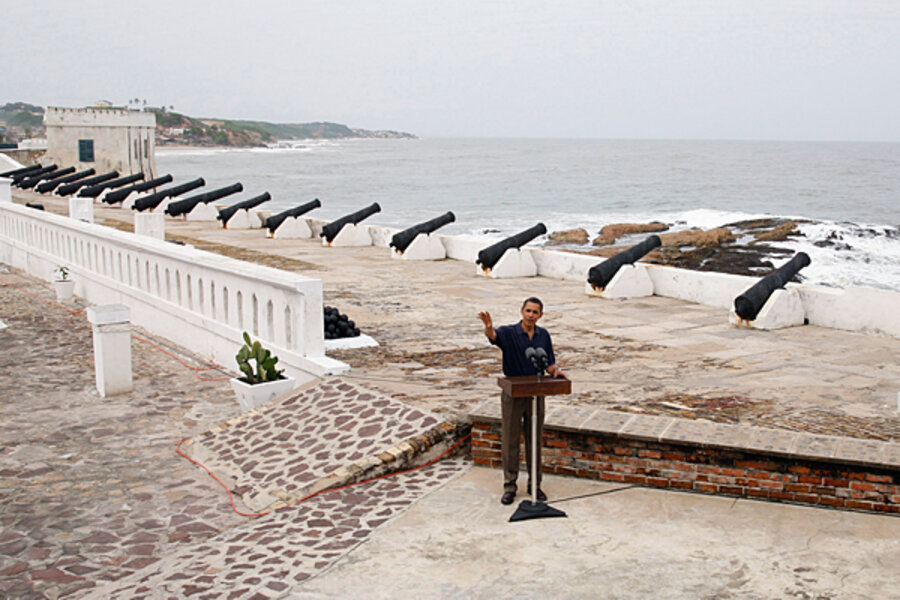Rising seas washing away Ghana's former slave forts
Loading...
| Ada Foah, Ghana
The ocean is starting to wash away historical slave trading forts and castles on the coast of Ghana, threatening a thriving tourist industry as well as the homes of coastal dwellers.
The waves have already taken a toll on Ada Foah’s Fort Kongenstein, an 18th century Danish trading fort. All that remains of it are dilapidated foundations and collapsing arches hanging off of a shelf of sand. The sea has claimed the rest.
The beating taken by this smaller fort may soon be in store for the castles at Cape Coast and Osu, both UNESCO World Heritage sites, along with most of the coastal forts and key attractions for the country’s $2.1 billion tourist industry.
The forts were built by the Danish for defense and slave trading before eventually coming under the control of the British in the 19th century, and their foundations on rocky terrain affords them some protection, says scientist Kwasi Appeaning Addo, but they, too, will fall to the tides if measures are not taken. The castle at Osu, which is also the seat of government, may flood as soon as 2050, Mr. Addo says.
“Erosion is a major threat to coastal tourism,” says Addo, a lecturer in coastal science at the University of Ghana. “The foreign castles are particularly at risk.”
Blame climate change, Addo says. Sea levels in parts of Accra, Ghana’s capital, could rise by up to 80 centimeters by 2100, according to a study he authored. The coast in the capital is receding at just over one meter a year, he says, while Ada Foah loses about 3.5 meters a year, according to a recent University of Ghana study.
Local causes, too
But also to blame is the growth of human population along the coast, which will likely be exacerbated as Ghana’s offshore oil industry brings more people to the shores for work. Also not helping: the practice of "sand winning," where soil is taken from the beach as a cheap building material for houses.
In addition, the tides determine if Enoch Tawiah has a home.
When the seas are low, Mr. Tawiah fishes tuna and redfish in the azure waters behind his house. But when the ocean surges, he and the other residents of the eastern Ghana town of Ada Foah must flee inland, with no assurance that their homes will be there when they get back.
“People that are not lucky, [the water] will break their houses,” Tawiah says. He estimates over 100 of his neighbors evacuate – to the homes of relatives, if they’re lucky – during storms.
Adaptation efforts
With the beach retreating, the government has tried to encourage the residents of Ada Foah to follow suit, offering to resettle them further inland, says Eugene Dugbatey, a district assemblyman. They won’t go, Mr. Dugbatey says; the sea is where these fishermen make their money.
So Ghana’s government has stepped in with expensive infrastructure projects meant to preserve the coast.
A sea defense wall is under construction in Ada, made of a series of rock groins that jut perpendicularly from the shore.
“It’s a sand trap,” says Andre Olivier, a site engineer for the $78 million project that is expected to finish at the end of next year. “You’re stopping the current” behind the rocks “and then sedimentation takes place."
Groins are used elsewhere along the Ghanaian coast. Further east, near the city of Keta, a series of groins protects Fort Prinzensten, another Danish settlement that was nearly destroyed by waves before the walls were built, according to a report by UNESCO.
Near Accra, the UNESCO report said the sloping piles of rocks that prevent further soil erosion called revetments are shoring up beaches that have already sustained erosion.
But groins only go so far to alleviate erosion, Addo says. While the areas upstream of the groins may recover, those downstream will be depleted further. And curbing erosion is not Ghana’s job alone, he argues.
“What happens in Côte d'Ivoire eventually affects Ghana. What happens in Ghana is affecting Togo and affecting Benin and may affect Nigeria,” he says. He called for the countries to work together to come up with a strategy to combat erosion.
Still, Tawiah holds out hope that the groins lining the beach will save his home and livelihood.
“When the sea defense wall [is built], then I think we can stay,” Tawiah says. Until then, he will be at the mercy of the seas. “For now there is no change. For now.”





